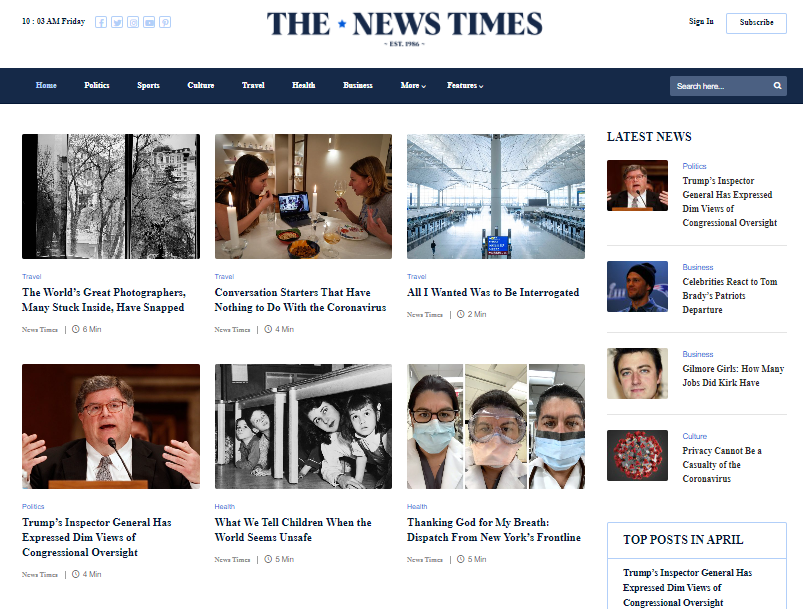The Place of stnews.live in the Real-Time News Ecosystem
Wiki Article
The Impact of Social Network heading We Eat News Online
Social media site has essentially transformed news usage. It supplies instant access to information, commonly eclipsing traditional media outlets. This rapid dissemination comes with difficulties. Individuals encounter the risk of encountering misinformation and coming to be trapped in resemble chambers. The algorithms driving tailored content can cover varied viewpoints. As these characteristics develop, understanding their effects ends up being necessary for informed engagement in public discourse. What methods might assist browse this complex landscape?The Advancement of News Intake in the Digital Age
As innovation progressed, the way individuals taken in news changed significantly in the electronic age (stnews.live). Standard newspapers and broadcast media began to decrease as the internet arised as a primary source of details. Online platforms provided immediate accessibility to news write-ups, video clips, and podcasts, permitting individuals to stay notified at any moment. The ease of mobile gadgets better accelerated this change, enabling users to get updates on the moveAdditionally, the increase of news collectors and sites facilitated the intake of varied viewpoints, encouraging customers to tailor their news consumption based on individual passions. This advancement additionally triggered wire service to adapt their techniques, concentrating on digital content and appealing viewers through multimedia formats. Because of this, the traditional barriers of time and space in news delivery decreased, causing a more instant and customized news experience for target markets worldwide.
The Role of Social Media Site Operatings Systems in News Circulation
Social network systems have transformed news circulation by giving instant accessibility to information. Their algorithm-driven web content curation commonly prioritizes interaction over accuracy, causing considerable integrity difficulties (stnews.live). As customers navigate this landscape, the effects for news intake and public discourse ended up being significantly complicatedImmediate News Accessibility
Although traditional news outlets have long been the main source of info, the surge of social media sites platforms has actually dramatically changed exactly how news is accessed and consumed. Instant news accessibility has actually become a hallmark of the electronic age, enabling customers to receive updates in genuine time. Platforms such as Twitter, Facebook, and Instagram allow news to spread out rapidly, commonly exceeding standard media in rate and reach. Users can share tales, talk about events, and involve with reporters, developing a vibrant communication between the target market and news material. This immediacy fosters a culture of urgency, triggering customers to seek info rapidly. Subsequently, the assumption for timely news has reshaped journalistic techniques, engaging news companies to adjust their approaches to satisfy the needs of a busy digital atmosphere.Algorithm-Driven Web content
While customers actively engage with material on social networks, the algorithms that regulate these platforms play an essential role in establishing which news tales get visibility. These formulas assess individual actions, preferences, and involvement metrics to curate individualized news feeds. Because of this, certain tales may be enhanced while others continue to be rare, commonly prioritizing astonishing or trending subjects over substantive coverage. This careful direct exposure forms customers' understandings of current occasions and affects public discussion. Moreover, the dependence on algorithm-driven material can create echo chambers, where users are mostly revealed to viewpoints that align with their own ideas. Subsequently, the characteristics of news circulation on social networks platforms significantly impact just how individuals eat and interpret details in the electronic age.
Credibility Challenges
As customers increasingly turn to social media for news, the integrity of info come across on these platforms becomes a pressing issue. The decentralized nature of social networks permits any individual to publish material, commonly blurring the lines in between trustworthy journalism and misinformation. Algorithms focus on involvement over precision, leading to the prevalent circulation of astonishing or deceptive stories. This environment presents substantial challenges for individuals trying to determine reliable sources. Social media platforms, while endeavoring to fight misinformation via fact-checking and content small amounts, face objection for inconsistencies and predispositions in their techniques. Inevitably, the obligation lies with individuals to seriously examine the news they eat, as the fast spread of details frequently outpaces verification initiatives by systems.The Surge of Resident Journalism and User-Generated Web Content
The rise of person journalism has actually equipped everyday individuals to share news and viewpoints, commonly offering insights that traditional media may forget. Nonetheless, this change likewise offers considerable difficulties, especially the spread of misinformation that can emerge from unverified material. As user-generated material becomes much more widespread, the equilibrium in between genuine voices and accuracy in coverage continues to be an important concern.Equipping Everyday Voices

Challenges of False information
While the surge of citizen journalism has opened up opportunities for varied voices in the media landscape, it has actually likewise presented considerable challenges associated with misinformation. The ease of sharing info through social media systems allows individuals to distribute news quickly, yet this quick spread often comes at the cost of accuracy. User-generated material frequently does not have the extensive fact-checking and content oversight that traditional journalism gives. Subsequently, sensationalized or false narratives can gain traction, misdirecting target markets and forming public understanding (stnews.live). The blending here are the findings of opinion and fact within social media makes complex the distinction between trustworthy details and misinformation. As an outcome, consumers must navigate a progressively complex media atmosphere, needing essential assuming skills to recognize trusted news sources amidst the noise
False information and Its Effects for Public Discourse
As social networks platforms progressively dominate the landscape of information circulation, the proliferation of false information postures substantial difficulties for public discourse. False information, usually developed to deceive or prompt emotional feedbacks, can misshape understandings of truth and threaten rely on qualified sources. This phenomenon leads to polarized viewpoints, as people move towards echo chambers that strengthen their ideas, further setting departments within society.The ramifications for public discussion are profound. When residents count on incorrect information, purposeful dialogue reduces, and the autonomous process experiences. Misinformation can prompt worry and complication, affecting public health, safety, and political stability. Therefore, fostering media proficiency ends up being crucial, encouraging individuals to seriously examine information and discern reality from fiction. Attending to the difficulties postured by misinformation is important for protecting the honesty of public discourse and making certain a well-informed populace with the ability of taking part in positive conversations.
The Impact of Formulas on News Presence
Offered the central duty of formulas in determining content exposure, their influence on news consumption is extensive. These formulas, utilized by social media sites platforms, prioritize specific types of material based on user engagement and preferences. Because of this, newspaper article that straighten with preferred trends or target market rate of interests are a lot more most likely to be displayed prominently, while less marvelous stories may be forgotten. This develops an atmosphere where customers are revealed largely to information that reinforces their viewpoints, potentially bring about echo chambers.The continuous advancement of algorithms indicates that news companies need to adapt their strategies to align with these changing parameters, typically look at more info focusing on clickbait or psychologically charged headlines. The stability of news coverage can be jeopardized, as crucial tales might not obtain the exposure they are entitled to. The mathematical shaping of news presence consequently plays a vital function in affecting public perception and understanding of present occasions.
The Change Toward Visual Narration in News Media
Significantly, news media is embracing aesthetic narration as an effective device to engage audiences. This strategy leverages photos, videos, infographics, and interactive elements to communicate information better than traditional text-based formats. As interest extends reduce, visuals provide a quick, impactful method to connect intricate tales and order customers' interest.Platforms like Instagram and TikTok have additional accelerated this trend, engaging news organizations to adapt their web content methods to fit these visually-driven atmospheres. By incorporating engaging visuals, news outlets can improve psychological connections and foster greater understanding of topical issues.
Aesthetic storytelling allows for even more diverse narratives, showcasing several point of views through vibrant discussions. As target markets progressively take in news via smart phones, the change towards visuals not only satisfies user preferences however additionally helps to damage down obstacles to information access. Eventually, this advancement mirrors a broader change in just how news is created and consumed in the electronic age.
Future Fads: Browsing the Transforming Landscape of News Usage
While the digital landscape remains to develop, news consumption is positioned for considerable makeover driven by emerging innovations and altering audience actions. As expert system and equipment understanding breakthrough, personalized news feeds will certainly end up being extra common, permitting users to get material tailored to their interests. This personalization can lead to better involvement yet also increase concerns regarding echo chambers and false information.The rise of voice-activated devices and wise audio speakers will influence how news is delivered, changing the emphasis from visual to auditory formats. This fad might motivate wire service to take on more succinct and interesting audio web content.

Regularly Asked Questions
Exactly How Do Social Media Site Interactions Affect News Credibility?
Social media interactions can considerably influence assumptions of news integrity. Engagement metrics, such as likes and shares, commonly shape target market depend on, with preferred articles getting viewed authenticity, regardless of the accuracy or reliability of the information provided.What Function Do Influencers Play in Shaping News Narratives?
Influencers substantially shape news stories by leveraging their platforms to enhance certain stories, commonly tailoring web content to their audience. This can lead to biased viewpoints, impacting public understanding and focusing on sensationalism over factual reporting.Just How Can Users Identify Reliable News Sources on Social Network?
Individuals can determine dependable news sources on social media by checking the source's reliability, validating truths via numerous outlets, evaluating the professionalism and reliability of the material, and acknowledging possible prejudices in reporting to guarantee exact info.What Impact Does Social Media Site Carry Typical Journalism Jobs?
Social media considerably affects traditional journalism jobs by altering revenue models, reducing need for print media, and promoting competitors from person journalists. Many professionals encounter work instability and must adapt to rapidly transforming media landscapes.Just How Do Different Demographics Consume News on Social Media Site?
Different demographics exhibit different choices for news usage on social media. More his explanation youthful target markets prefer systems like TikTok and Instagram for quick updates, while older people often tend to choose Facebook and Twitter for extra in-depth conversations and short articles.Report this wiki page